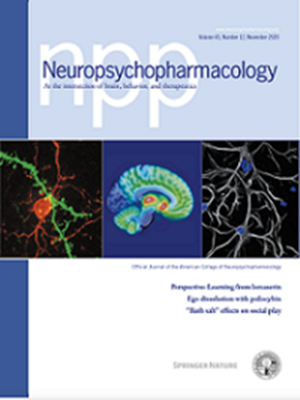Pharmacological reduction of reverse-translated hippocampal hyperactivity in mouse: relevance for psychosis
IF 6.6
1区 医学
Q1 NEUROSCIENCES
引用次数: 0
Abstract
Hippocampal hyperactivity (HH) is a potential biomarker in schizophrenia psychosis, which also appears in several other brain disorders, compromising specificity. We hypothesized that the reversal of HH in an established, reverse-translational animal preparation, coupled with a behavioral marker of psychosis may be a predictor of antipsychotic efficacy of a medication. We used a chemogenetic reverse-translational mouse preparation relevant to schizophrenia psychosis which shows HH and aberrant psychosis-relevant behaviors, specifically disrupted social recognition memory (SRM). Mice with and without HH were treated with three drugs; two known antipsychotics and one HH-reducing anticonvulsant, to assess their effects on both HH and SRM performance. All animals received one of the four treatments: vehicle (N = 15–24), haloperidol (N = 8–15), xanomeline (N = 8–13) or levetiracetam (N = 6–15) and were subsequently tested for baseline c-Fos protein expression within the hippocampal subfields (CA3 and CA1) as a measure of neuronal activity, or tested with the SRM task as a measure of social memory. All three drugs acutely reduced baseline HH compared to vehicle treatment. Subacute administration of haloperidol or xanomeline, the two drugs known to have antipsychotic activity, but not levetiracetam, normalized the SRM behavior to control levels. These results suggest that the reversal of HH alone cannot be a predictor of antipsychotic efficacy of an experimental drug and HH as a biomarker could benefit from a more sensitive readout approach.

小鼠海马反翻译亢进的药理学减少:与精神病的相关性。
海马多动症(HH)是精神分裂症精神病的潜在生物标志物,它也出现在其他几种脑部疾病中,损害了特异性。我们假设,在一个已建立的,反向翻译的动物制剂中,HH的逆转,加上精神病的行为标记,可能是药物抗精神病疗效的预测因子。我们使用了与精神分裂症精神病相关的化学遗传学反向翻译小鼠制备,该制备显示HH和异常精神病相关行为,特别是破坏社会识别记忆(SRM)。有和没有HH的小鼠用三种药物治疗;两种已知的抗精神病药物和一种降低HH的抗惊厥药物,以评估它们对HH和SRM表现的影响。所有动物接受四种治疗中的一种:药(N = 15-24)、氟哌啶醇(N = 8-15)、异丙胺(N = 8-13)或左乙拉西坦(N = 6-15),随后测试海马亚区(CA3和CA1)内c-Fos蛋白的基线表达,作为神经元活动的测量,或用SRM任务测试作为社会记忆的测量。与载体治疗相比,这三种药物均可显著降低基线HH。亚急性给予氟哌啶醇或异诺米林这两种已知具有抗精神病活性的药物,而不是左乙拉西坦,使SRM行为正常化到控制水平。这些结果表明,HH的逆转不能单独预测实验性药物的抗精神病疗效,HH作为生物标志物可以从更敏感的读数方法中获益。
本文章由计算机程序翻译,如有差异,请以英文原文为准。
求助全文
约1分钟内获得全文
求助全文
来源期刊

Neuropsychopharmacology
医学-精神病学
CiteScore
15.00
自引率
2.60%
发文量
240
审稿时长
2 months
期刊介绍:
Neuropsychopharmacology is a reputable international scientific journal that serves as the official publication of the American College of Neuropsychopharmacology (ACNP). The journal's primary focus is on research that enhances our knowledge of the brain and behavior, with a particular emphasis on the molecular, cellular, physiological, and psychological aspects of substances that affect the central nervous system (CNS). It also aims to identify new molecular targets for the development of future drugs.
The journal prioritizes original research reports, but it also welcomes mini-reviews and perspectives, which are often solicited by the editorial office. These types of articles provide valuable insights and syntheses of current research trends and future directions in the field of neuroscience and pharmacology.
 求助内容:
求助内容: 应助结果提醒方式:
应助结果提醒方式:


